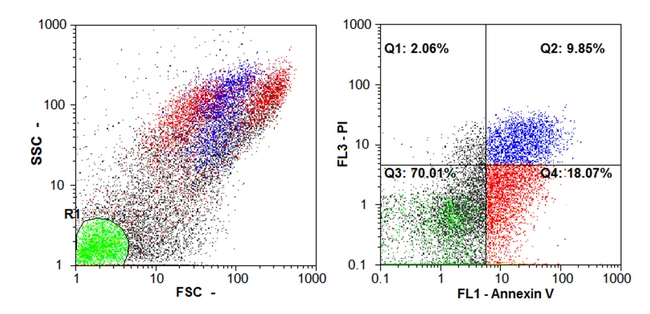
Flow-cytometric analysis of programmed cell death
Jan Balvan, Martina Raudenska, Michal Masarik, Rene Kizek
Programmed cell death (PCD) is a crucial process required for the normal development and physiology of metazoans. The three major mechanisms that induce PCD are called type I (apoptosis), type II (autophagic cell death), and type III (necrotic cell death). Dysfunctional PCD leads to diseases such as cancer and neurodegeneration. Although apoptosis is the most common form of PCD, recent studies have provided evidence that there are other forms of cell death. The high majority of classical apoptotic hallmarks can be rapidly examined by flow cytometry. Cytometry thus became a technology of choice in diverse studies of cellular demise. A large variety of cytometric methods designed to identify apoptotic cells and probe mechanisms associated with this mode of cell demise have been developed during the past two decades.

Fig. 1: Histogram showing the percentage of each type of cell death in a cell population (staining with annexin V and PI) Q1: an enucleated cell fragments and nuclei positive, PI negative for annexin; Q2: Necrotic cells positive for both PI and Annexin; Q3 viable cells are negative for both dyes; Q4 apoptotic cells negative for PI positive Alexa
1. Schultz, D.R.; Harrington, W.J. Apoptosis: Programmed cell death at a molecular level. Seminars in Arthritis and Rheumatism. 2003, 32, 345-369.
2. Ouyang, L.; Shi, Z.; Zhao, S.; Wang, F.T.; Zhou, T.T.; Liu, B.; Bao, J.K. Programmed cell death pathways in cancer: a review of apoptosis, autophagy and programmed necrosis. Cell Proliferation. 2012, 45, 487-498.
3. Henry, C.M.; Hollville, E.; Martin, S.J. Measuring apoptosis by microscopy and flow cytometry. Methods. 2013, 61, 90-97.
4. Bertho, A.L.; Santiago, M.A.; Coutinho, S.G. Flow cytometry in the study of cell death. Memorias Do Instituto Oswaldo Cruz. 2000, 95, 429-+.
5. Wu, D.Y.; Patti-Diaz, L.; Hill, C.G. Development and validation of flow cytometry methods for pharmacodynamic clinical biomarkers. Bioanalysis. 2010, 2, 1617-1626.
6. Elmore, S. Apoptosis: A review of programmed cell death. Toxicologic Pathology. 2007, 35, 495-516.
7. Rieger, A.M.; Hall, B.E.; Le Thuong, L.; Schang, L.M.; Barreda, D.R. Conventional apoptosis assays using propidium iodide generate a significant number of false positives that prevent accurate assessment of cell death. Journal of Immunological Methods. 2010, 358, 81-92.
8. Ormerod, M.G. Investigating the relationship between the cell cycle and apoptosis using flow cytometry. Journal of Immunological Methods. 2002, 265, 73-80.
9. Qin, L.F.; Ng, I.O.L. Induction of apoptosis by cisplatin and its effect on cell cycle-related proteins and cell cycle changes in hepatoma cells. Cancer Letters. 2002, 175, 27-38.
10. Telford, W.G. Detecting apoptosis by flow cytometry: a practical guide. Cytometry Part B-Clinical Cytometry. 2012, 82B, O8-O8.
11. Slee, E.A.; Harte, M.T.; Kluck, R.M.; Wolf, B.B.; Casiano, C.A.; Newmeyer, D.D.; Wang, H.G.; Reed, J.C.; Nicholson, D.W.; Alnemri, E.S.; Green, D.R.; Martin, S.J. Ordering the cytochrome c-initiated caspase cascade: Hierarchical activation of caspases-2, -3, -6, -7, -8, and -10 in a caspase-9-dependent manner. Journal of Cell Biology. 1999, 144, 281-292.
J.Met.Nano:
volume-1, issue-3
- Personal and professional representation of the nanolabsys project
- Administration and information system of the project
- Microwave preparation of carbon quantum dots with different surface modification
- Cell lines as a model system for quantum dots applications
- Application of quantum dots into chicken embryos
- The influence of zinc to living organisms
- The influence of cadmium to living organisms
- The influence of lead to living organisms
- The influence of mercury to living organisms
- Monitoring of metallothionein levels in biological organism exposed to the metal elements and compounds
- The ratio of GSH/GSSG in biological organisms
- Amino Acids and their interactions with heavy metals
- Antioxidat enzymes – biochemical markers of oxidative stress
- Study of the interaction of quantum dots with tumor cells by fluorescence microscopy
- Flow-cytometric analysis of programmed cell death
- Bacteriophage λ as a doxorubicin nanocarrier
 PDF
PDF